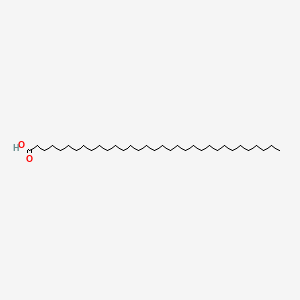| MeSH term | MeSH ID | Detail |
|---|---|---|
| Diabetes Mellitus, Type 2 | D003924 | 87 associated lipids |
| Hypercholesterolemia | D006937 | 91 associated lipids |
| Body Weight | D001835 | 333 associated lipids |
tritriacontanoic acid
tritriacontanoic acid is a lipid of Fatty Acyls (FA) class. Tritriacontanoic acid is associated with abnormalities such as hypercholesterolemia, Metabolic syndrome, Diabetes Mellitus, Non-Insulin-Dependent, Diabetes Mellitus, Insulin-Dependent and Parkinson Disease. The involved functions are known as Fermentation, Process, Longterm Effects, Pressure- physical agent and Lipid Metabolism. Tritriacontanoic acid often locates in Blood, Tissue fiber and A Fibers. The associated genes with tritriacontanoic acid are STN gene. The related lipids are Total cholesterol and blood lipid.
Cross Reference
Introduction
To understand associated biological information of tritriacontanoic acid, we collected biological information of abnormalities, associated pathways, cellular/molecular locations, biological functions, related genes/proteins, lipids and common seen animal/experimental models with organized paragraphs from literatures.
What diseases are associated with tritriacontanoic acid?
tritriacontanoic acid is suspected in hypercholesterolemia, Metabolic syndrome, Diabetes Mellitus, Non-Insulin-Dependent, Diabetes Mellitus, Insulin-Dependent, Parkinson Disease and other diseases in descending order of the highest number of associated sentences.
Related references are mostly published in these journals:
| Disease | Cross reference | Weighted score | Related literature |
|---|
Possible diseases from mapped MeSH terms on references
We collected disease MeSH terms mapped to the references associated with tritriacontanoic acid
PubChem Associated disorders and diseases
What pathways are associated with tritriacontanoic acid
There are no associated biomedical information in the current reference collection.
PubChem Biomolecular Interactions and Pathways
Link to PubChem Biomolecular Interactions and PathwaysWhat cellular locations are associated with tritriacontanoic acid?
Visualization in cellular structure
Associated locations are in red color. Not associated locations are in black.
Related references are published most in these journals:
| Location | Cross reference | Weighted score | Related literatures |
|---|
What functions are associated with tritriacontanoic acid?
Related references are published most in these journals:
| Function | Cross reference | Weighted score | Related literatures |
|---|
What lipids are associated with tritriacontanoic acid?
Related references are published most in these journals:
| Lipid concept | Cross reference | Weighted score | Related literatures |
|---|
What genes are associated with tritriacontanoic acid?
Related references are published most in these journals:
| Gene | Cross reference | Weighted score | Related literatures |
|---|
What common seen animal models are associated with tritriacontanoic acid?
There are no associated biomedical information in the current reference collection.
NCBI Entrez Crosslinks
All references with tritriacontanoic acid
Download all related citations| Authors | Title | Published | Journal | PubMed Link |
|---|---|---|---|---|
| Cavallari C et al. | Ex-vivoand in-vitro assessment of mucoadhesive patches containing the gel-forming polysaccharide psyllium for buccal delivery of chlorhexidine base. | 2015 | Int J Pharm | pmid:26541304 |
| Vega López AB et al. | Response to letter Dr. McRorie. | 2015 | Neurogastroenterol. Motil. | pmid:26503165 |
| McRorie JW | Psyllium is not fermented in the human gut. | 2015 | Neurogastroenterol. Motil. | pmid:26503164 |
| Gibb RD et al. | Psyllium fiber improves glycemic control proportional to loss of glycemic control: a meta-analysis of data in euglycemic subjects, patients at risk of type 2 diabetes mellitus, and patients being treated for type 2 diabetes mellitus. | 2015 | Am. J. Clin. Nutr. | pmid:26561625 |
| Cicero AF | Metamucil as an additional source of dietary fiber: impact of the quality of healthcare professionals' recommendations on users' experience. | 2015 | Eur Rev Med Pharmacol Sci | pmid:25912593 |
| Chen YA et al. | Small bowel obstruction following computed tomography and magnetic resonance enterography using psyllium seed husk as an oral contrast agent. | 2014 Jul-Aug | Can J Gastroenterol Hepatol | pmid:25157531 |
| Sharma VK and Mazumdar B | Characterization of gliclazide release from Isabgol husk hydrogel beads by validated HPLC method. | 2014 Jan-Feb | Acta Pol Pharm | pmid:24779204 |
| Niinistö K et al. | Comparison of the effects of enteral psyllium, magnesium sulphate and their combination for removal of sand from the large colon of horses. | 2014 | Vet. J. | pmid:25458886 |
| Masood R et al. | Novel materials for moist wound management: alginate-psyllium hybrid fibres. | 2014 | J Wound Care | pmid:24633061 |
| Crocetti D et al. | Psyllium fiber food supplement in the management of stoma patients: results of a comparative prospective study. | 2014 | Tech Coloproctol | pmid:23430350 |
